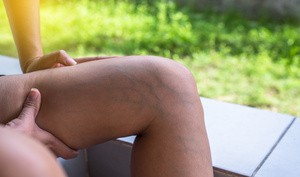The vascular system of our body comprises of blood vessels which carry blood from the heart to various body parts and then back to the heart. Peripheral vasculature comprises of all the blood vessels of the body except those supplying the heart and brain. Peripheral vascular diseases occur in 40 to 50 percent of the adult population.
A peripheral vascular disease is a form of arterial insufficiency, meaning that blood circulation through the arteries (blood vessels that carry blood away from the heart) is decreased. The term peripheral vascular disease is commonly used to refer to peripheral artery disease or peripheral arterial disease, meaning narrowing or occlusion by atherosclerotic plaques of arteries. This results in ineffective blood supply to the body parts.
Varicose veins is another condition affecting the peripheral vasculature. Varicose veins are veins under the skin of the legs, which have become widened, bulging, and twisted. They are very common and do not cause medical problems in most people. There are two main systems of veins in the legs which are deep veins and superficial veins.
All of these veins contain one-way valves to ensure that the blood flows towards the heart. Failure of these valves allows blood to flow backwards down the veins and results in an overload of pressure when standing. This excess pressure leads to widening of the veins so that they do not close properly. Blood then flows back into the leg along these veins and causes varicose veins to develop. Raised pressure in these veins also encourages the development of spider veins and discolored.
Signs and symptoms of the vascular disease often appear gradually. They occur more commonly in the legs than the in arms because the blood vessels in the legs are further from the heart.
Pains, aches, or cramps while walking are typical symptoms of vascular disease. Pain and discomfort is related to walking in areas like buttock, calves, and thighs.
Other symptoms of vascular disease include pale or reddish-blue legs or arms, leg cramps when lying down, skin that is cool to the touch, slow-healing wounds, and ulcers, or cold, burning, or numb toes. Your muscles may feel heavy and your muscles may have a numb sensation. Thickened toenails can also indicate vascular disease.
Varicose veins commonly occur in areas of the leg like thighs, calves. Common symptoms include aching, discomfort and heaviness of the legs, which are usually worse at the end of the day. Sometimes the ankle can swell, too. These symptoms are not medically serious but can be treated if they are sufficiently troublesome. They may also pose a cosmetic problem as the veins are visible through the skin. In a few people, the high pressure in the veins causes damage to the skin near the ankle, which can become brown in colour, sometimes with scarred white areas. Eczema (a red skin rash) can develop. If these skin changes are allowed to progress or if the skin is injured and skin ulcers may develop.
Any of the above-mentioned symptoms make it necessary to see a vascular surgeon. Endovenous laser therapy is a painless alternative for getting rid of vascular disease.
Dr. Abhilash Shandalya is one of the best vascular surgeons in Hyderabad. He is a well-known specialist for varicose veins. He has successfully treated varicose veins for more than 5,000 patients. He has performed the ELVT procedure for the past 4 years with great results.
You can visit Flow Vascular clinic at H.No: 2-22-298/2/A, Sree Krishna Diagnostic Center Building, 2nd Floor, Beside Kalamandir, KPHB Main Road, Kukatpally, Hyderabad. You can also book an appointment on https://drabhilash.com/book-an-appointment/ or call on (+91) 99896 49498,99590 33037.
Visit https://drabhilash.com/ to know more about the treatment options for varicose veins.

